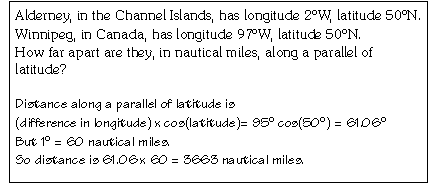
Start with a familiar sphere: the Earth (assume for the moment that it is spherical), spinning around an axis.
The North & South Poles are where this axis meets the Earth's surface. The equator lies midway between them.
The equator is an example of a great circle: one
whose plane passes through the centre of the sphere. Every great circle
has two poles. We can define these:
(a) as the points which are 90° away
from the circle, on the surface of the sphere.
(b) as the points where the perpendicular
to the plane of the great circle cuts the surface of the sphere.
These two definitions are equivalent.
Note that the length of a great-circle arc on the surface of a sphere is the angle between its end-points, as seen at centre of sphere, and is expressed in degrees (not miles, kilometres etc.).
A great circle is a geodesic (the shortest distance between two points) on the surface of a sphere, analogous to a straight line on a plane surface.
To describe a location on the surface of the Earth, we use latitude and longitude (two coordinates because the surface is two-dimensional).

Draw a great circle from pole to pole, passing through location X: this is a meridian of longitude.
The latitude of X is the angular distance along this meridian from the equator to X, measured from -90° at the South Pole to +90° at the North Pole.
The co-latitude of X is the angular distance from the North Pole to X = 90° - latitude.
There is no obvious point of origin for measuring longitude; for historical reasons, the zero-point is the meridian which passes through Greenwich (also called the Prime Meridian). The longitude of X is the angular distance along the equator from the Prime Meridian to the meridian through X. It may be measured east or west 0° to 360°, or both ways 0° to 180°.
Small circles parallel to equator are parallels of latitude. The circumference of a small circle at any given latitude is 360 x cos(latitude) degrees.
The length of arc of a small circle between two
meridians of longitude is
(difference in longitude) x
cos(latitude).
The great-circle distance is always less than this.
Celestial navigation used at sea (and in the air) involves spherical trigonometry, so the results are in angular measure (degrees). These must be converted to linear measure for practical use. We define the nautical mile as 1 arc-minute along a great circle on Earth's surface. This comes out about 15% greater than the normal "statute" mile (6080 feet instead of 5280 feet).

Note that a position on the surface of the Earth is fixed using one fundamental circle (the equator) and one fixed point on it (the intersection with Greenwich Meridian).
Return to index.